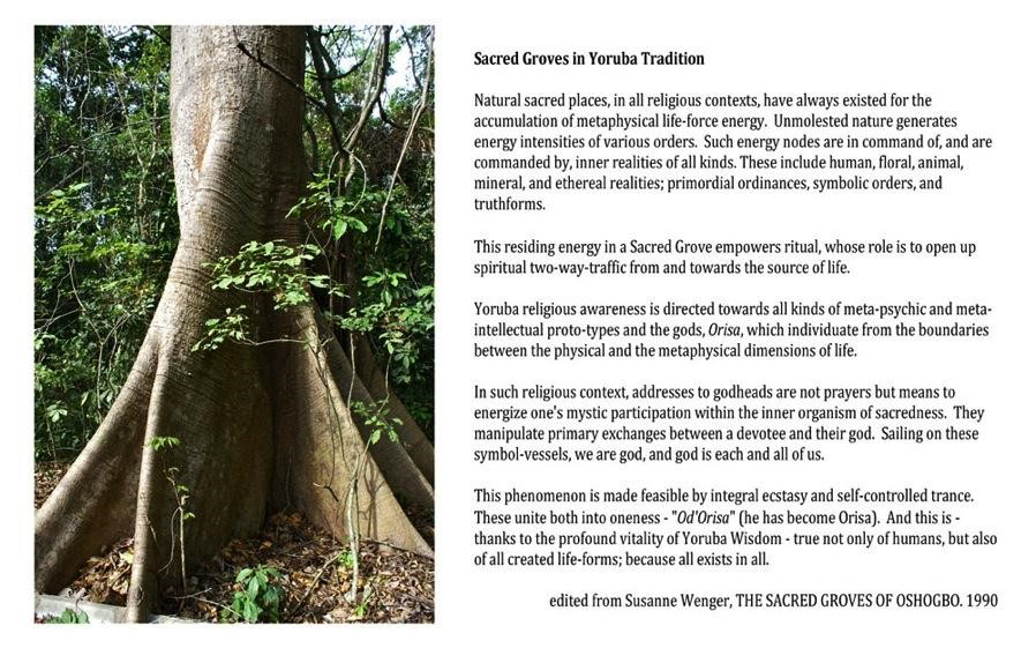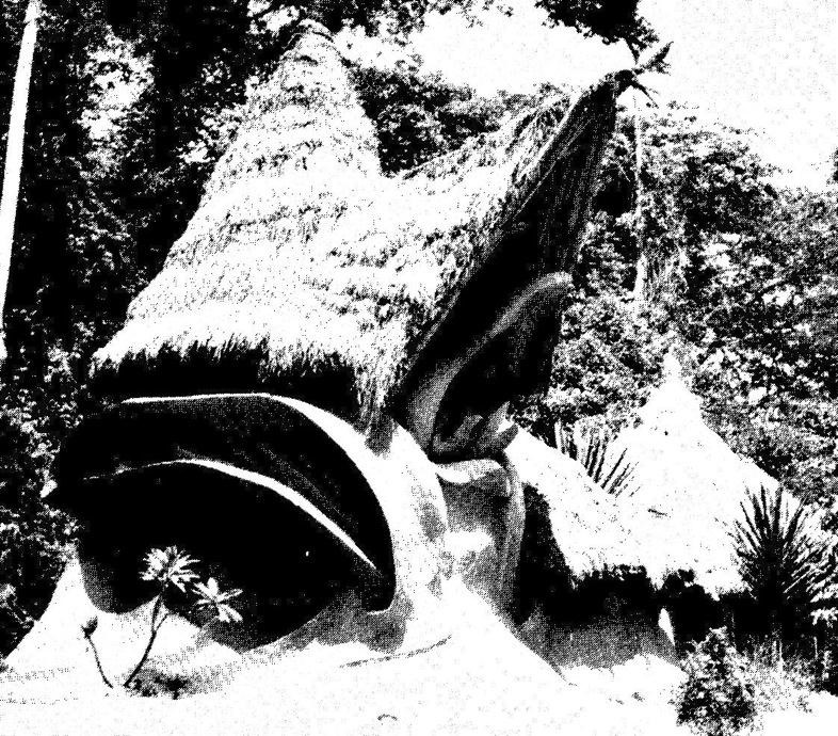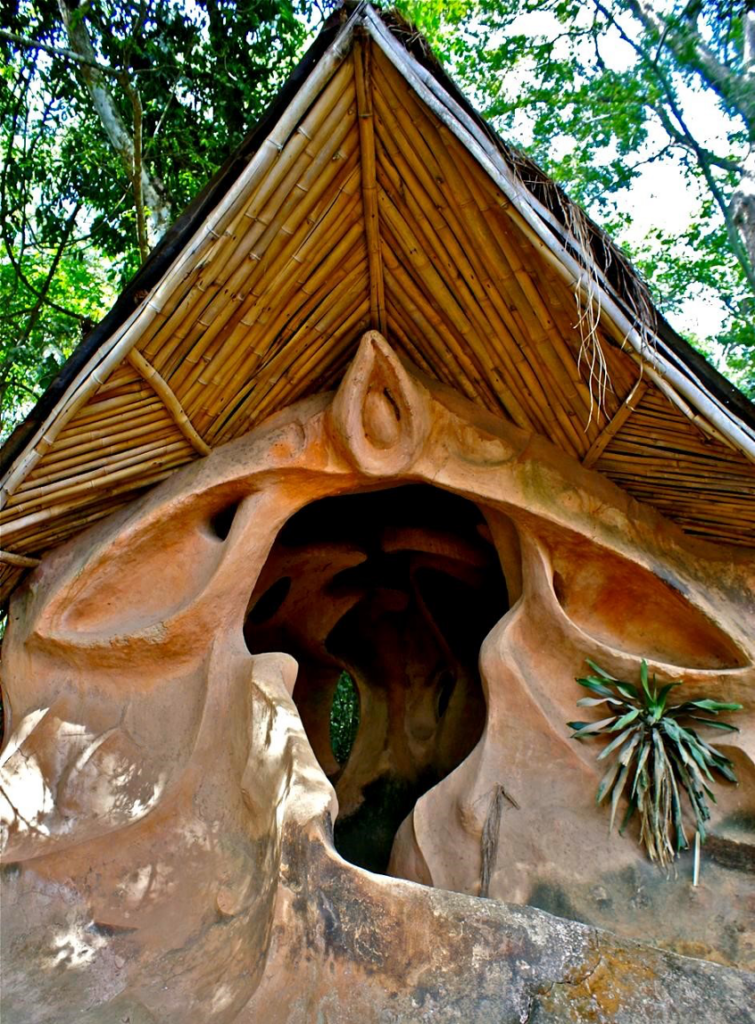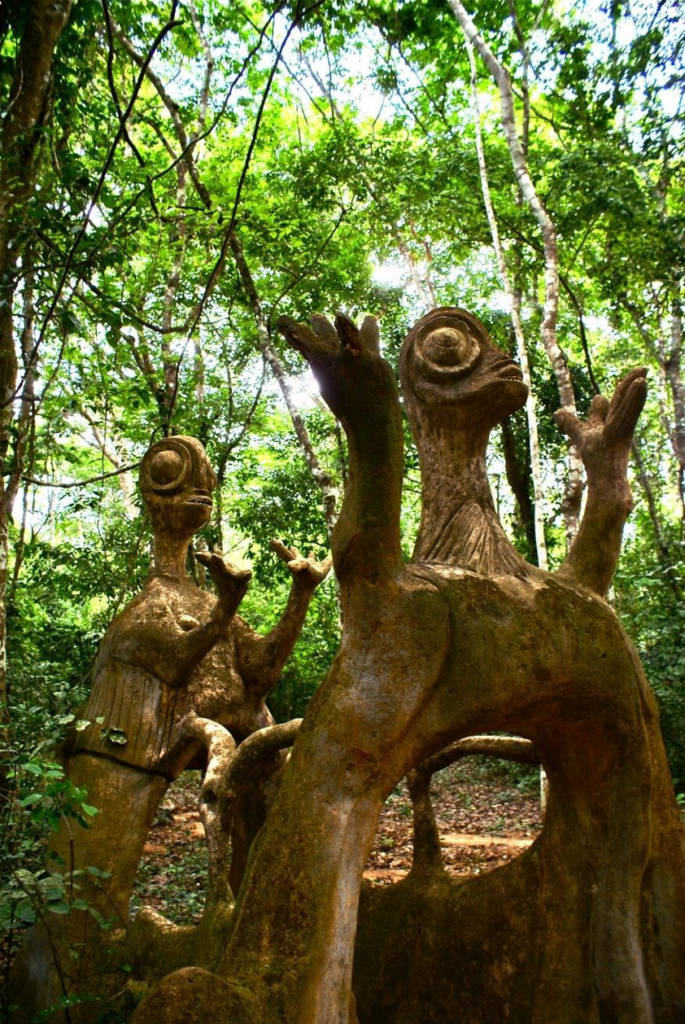Tom Bender
Sustainable Architecture and Economics tbender@nehalemtel.net
http://www.tombender.org
Introduction
Nigeria has suffered severely from religious strife and colonialism. Sacred traditions were banned, rainforests destroyed, people impoverished. In 1950, an Austrian woman artist, Suzanne Wenger, moved to Oshogbo, went into trance, and became a priestess at the Osun Sacred Grove. She subsequently channeled and co-created some 40 amazing elements of the shrine. Her first works were destroyed by Muslim fanatics.
The existence of the Grove and her work there are powerful illustrations of the profound differences and conflicts between cultures.
One of the most powerful written introductions to African spirituality, Malidoma Somé’s OF WATER AND THE SPIRIT, reveals profoundly different spiritual/cultural existence in traditional Africa:
“Traditional education consists of three parts:
- enlargement of one’s ability to see,
- destabilization of the body’s habit of being bound to one plane of being, and the ability to voyage trans-dimensionally and return.
Enlarging one’s vision and abilities has nothing supernatural about it. Rather, it is
“natural” to be part of nature and to participate in a wider understanding of reality.”
Via a recent personal divination with Somé, I have transformatively experienced the results of that education in action. It is life still in tune with the inner vibrations of nature. A life so vastly at odds with our own, that it powerfully challenges assumptions of our culture, architectural education, and practice.
Numerous images of Wenger’s work at the Osun Sacred Grove, accessible at my Flickr site, Flickr/qibender/sets, can give a visual sense of some of her work.
The presence of a white European woman at the Shrine, in central Africa, in the 1950s, was amazing to begin with. Abandoned by western medicine to die from tuberculosis, she was healed by traditional herbal medicines, and dedicated her life to the Shrine. Her presence, participation, and creations were key to survival of one of the last traditional spiritual practices there.
Her description of the core energetic dimension of the Grove’s operation matches (and predates by 20 years) my Physics of Qi Energy DVD:

As well as serving the “village” of Oshogbo (now 300,000 people), the Grove exists as a refuge for spirits from Spirit Groves of many communities that have been destroyed by deforestation of the country. The interaction-dynamics there of spiritual traditions remain complex. Adamant Christians still pressure Africans to deny and suppress their powerful integral capabilities of multidimensional spiritual existence. There remains fear of traditional emotional roots to existence and entry into “sacred” realms. Traditional culture is fantasized good-and-bad by current cultural dynamics.
There are interesting architectural issues from this meeting of cultures in her work:
- What are the positive and negative impacts of the introduction of physical (architectural) elements to places of spiritual experience? Individuals “educated” as in Somé’s culture do not require “architectural” place-markers to move between dimensions of existence and experience. Can architecture belittle, damage, or be a superficial replacement of forms of living more powerful than ours?
- Does architecture such as Wenger’s [or our’s] reinforce overconnectedness into the 3D dimension of our world? The powers of our “computer-peripheral” 3-D tools do overwhelm direct experience via integralconsciousness, requiring “Somé education”, drugs, meditation, or other means of turning off that noise. Does visually-powerful place-making focused on our 3-D experiencing tools distract from needed direct experiencing of the sacred?
- Does visual-preknowing reduce the power of rituals held in Wenger-places by creating pre-familiarity with mind-boggling event spaces? Imagine encountering the Ilédi Ontotoo (below) with no preparation or preconception, and under the influence of some mind-altering energy! Is that power diminished by
seeing a photo beforehand?
- Are there more benefits or losses from publicizing things such as Wenger’s creations at the Osun Shrine? They have created a valuable dimension of “credibility” in the Western culture, by making “visible” the existence of powerful African spiritual processes and their dramatic differences from Western religions. That credibility achieved, would it be furthered by absence of “creations” and focus directly on direct experience of multiple realms?
- What are the benefits/negatives of tourism and earth-plane celebrations with thousands of people? Everyone loves a party, and tourists love something weird and titillating. But every tourist takes away part of the soul of a place. And a party/celebration can be too big, distracting from intended focus of individual experience of the place.
- What are the values of durability vs. new creation? The Shrine’s director expressed to me their overwhelming needs for “preservation help”. Photos over time, and the amount of restoration work in process at the Shrine, show the issues of durability in a tropical rainforest. Powderpost beetles in the bamboo, rot and termites in wood posts. Moisture and moss penetration into soil-cement, concrete, and steel rebar. Wenger’s creations would be considered “structurally impossible” by many engineers, but they are in existence here for the moment.
What are the relative values of preserve the past, vs. encouraging the power of new creation?
Japanese Shinto shrines are rebuilt every 20 years, to keep their ritual energy of creation active in an ongoing cycle. Certain temples in India are allowed to decay into the earth rather than being repaired. Tibetan sand mandalas are swept into a pile of sand, and released into a waterway after the ritual. Egyptian temples are replaced as often as “repaired”. Would preservation by photography, and new creation, be better than massive on-going restoration?
Wenger strongly supports “new”. Her creations had relevance and power when made. But will the balance of all aspects of spirit and culture benefit from them having an extended physical life? Can both happen? What if something is especially amazing and loved?
- Sex, and ecstatic sexual energy, are core elements of life, and of the rituals and structures of the Shrine, but missing in most architecture elsewhere. Osun is a fertility goddess. Non-tribal religions imposed on Nigeria suppress and pervert sex. Sex is abusively exploited in commerce, subjugated and twisted in our institutional culture, and its power absent from our architecture. Other cultures joyfully incorporate and celebrate sexual energy in their spiritual practices, buildings, communities, and lives. Embracing it in our architecture can open our lives to missing dimensions of spiritual unity and initiate restoration of passion, joy, and unity to the core of our culture.
I haven’t experienced the fertility ritual at the Osun Shrine, so cannot address its effects. But Tantra and other energy-orgasm spiritual practices demonstrate the power possible through non-physical “sex” of achieving experience of unity, oneness, community, and openheartedness vital to a healthy culture. And many elements of the Grove are capable of enabling such experience. (See Sasha Cobra – Nitvana Energy Work)
- Feminine energy is currently virtually non-existent in our architecture. Even disregarding the Portal of the Virgin, Wenger’s work asserts a new and feminine aspect of architecture far beyond what I’ve seen elsewhere in the world.
- Finally, the curious characteristics of the humanistic figures at the Shrine raise interesting questions about the ancestry of all of us. Alberto Villoldo suggests that we start with a new assumption – that oral traditions are speaking truth, not myth. It might be extremely productive to research imagery from other cultures of their origin-ancestry. They may not be fantasy.
Lessons?
Ways to positively bring together powerful/diverse elements:
- Respect for channeling, and energetic processes of design.
- Design from EXPERIENCE, not talk-about.
- Focus on energized, primal-experience-empowered places . . . and lives.
- Honor the emotional, and multiplicity of tools for living and place-making.
- Expand views on spiritual institutions – perceptions helping re-evaluate our religious institutions and architectural processes.
Conclusions:
My primary conclusion from experiences related to this topic is that interweaving of karmic loops, different realms of existence, and energy-shifts occurring today are of scale and complexity beyond our comprehension; and that what we call “facts”, etc. are judgments based on extremely partial information. I feel we can raise questions, suggest possibilities, but not categorically assert ANY conclusions (including this).
Sources and Documentation:
For more information and documentation, my Architecture and the Sacred Index hyperlinks to forty-plus sources of my work specific to this topic – books, dvds, articles, chapters, presentations, monographs, calendars, built projects, etc. – and to their support references.
Specific Sources On Wenger, Osun, And African Spirituality:
Abiyamo, Susanne Wenger, Nigeria’s Mystical White High Priestess, (http://www.abiyamo.com/susannewenger–nigerias–mystical–white–high–priestess/ 2013)
Beier, Ulli. The Return of the Gods (New York NY: Cambridge University Press, 1975)
Bender, Tom. The Osun Sacred Grove, (https://www.flickr.com/photos/qibender/sets/72157643336529534/
2014)
Saunders, Nichola and Merzeder-Taylor, Augustine (eds.). Susanne Wenger: Her House and Her Art
Collection (Lagos NG, 2006)
SnapItOga, Osun-Oshogbo Sacred Grove in Nigeria (http://www.youtube.com/watch?v=F–NpEsvJ08Q,
2014)
Somé, Malidoma. Of Water and the Spirit (New York NY: Jeremy P. Tarcher/Putnam Book, 1994) Wenger, Susanne. The Sacred Groves of Oshogbo (Wien, AT: Verlag für Wissenswertes, 1990)
Aiyedakun: Wenger’s original shrine, destroyed by fanatics.


Ilédi Ontotoo – right wing: Now accessible only to initiates

Ile Iyemowoo – Portal of the Virgin for Fertility Ceremony

Gateway to Igbo Ifa, for initiates to back through into one sacred precinct.



